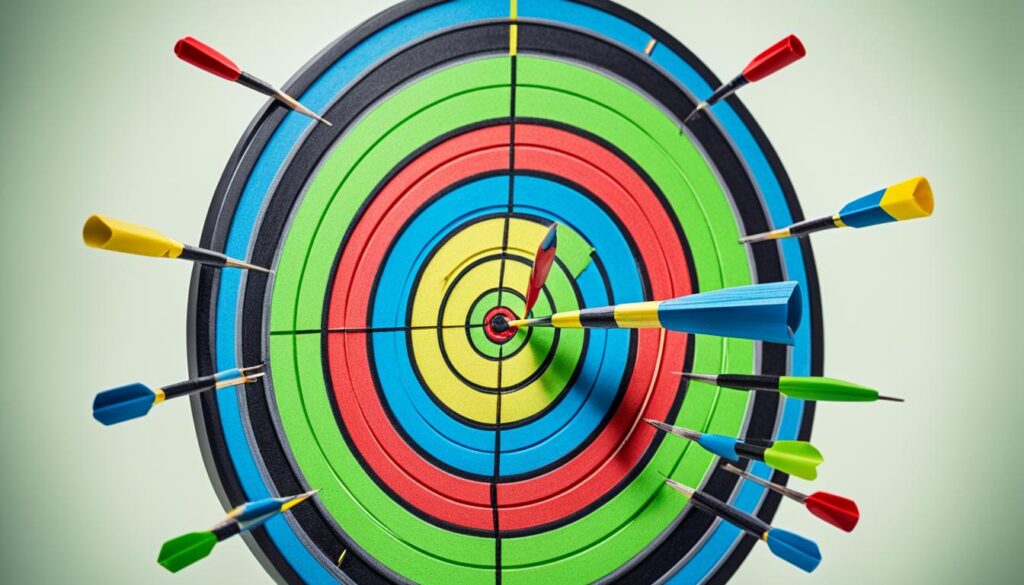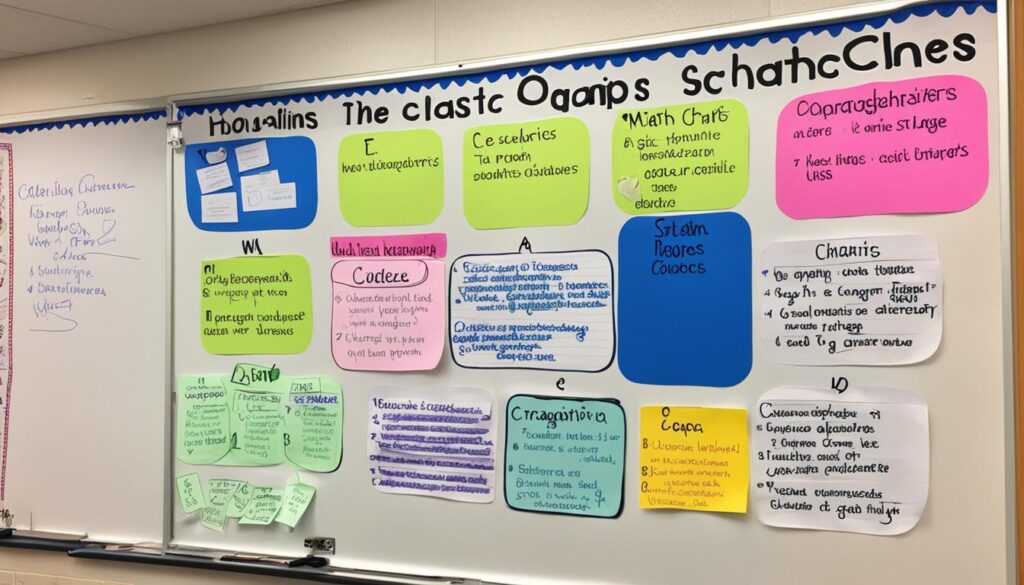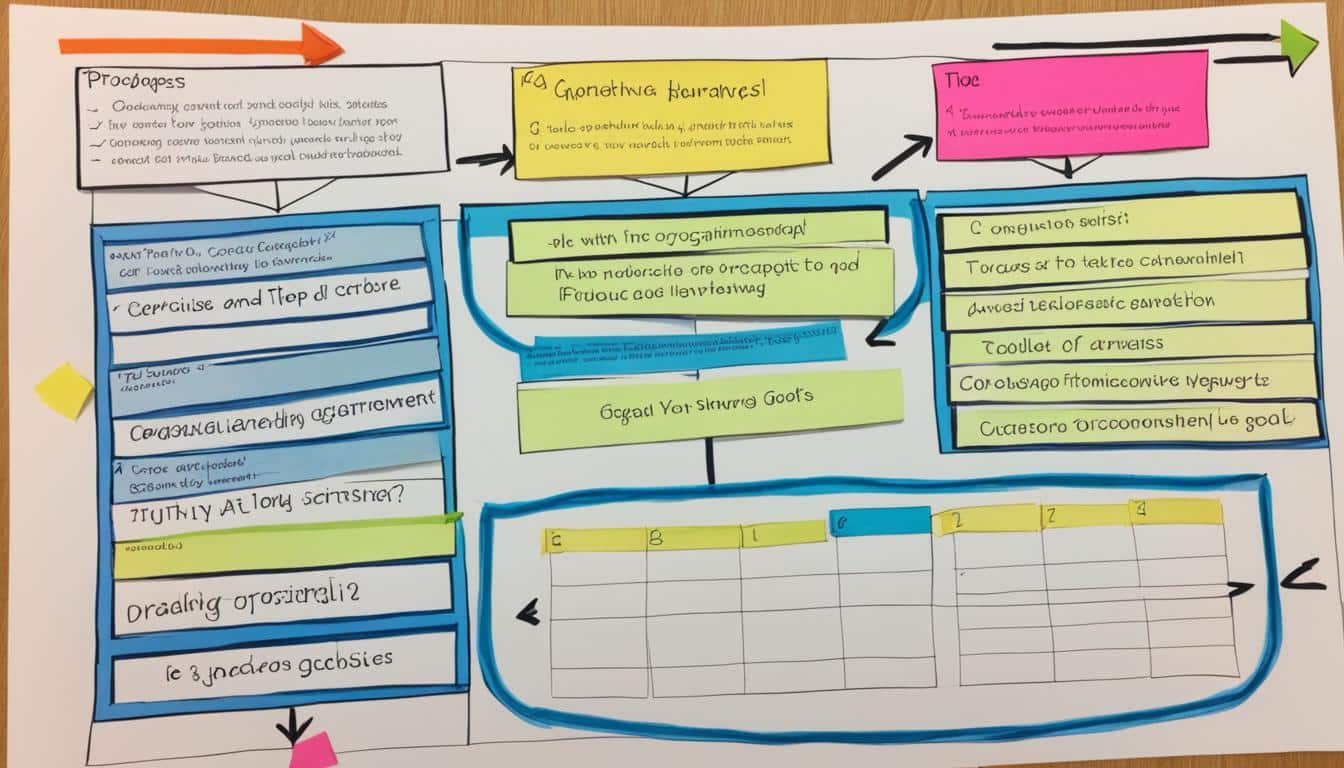Do you struggle to stay organized and focused on your assignments? Are you looking for a way to structure your goals and track your progress more effectively? Look no further than goal setting and graphic organizers. These powerful tools can revolutionize the way you approach your tasks and help you achieve success in your academic journey.
Setting specific goals and visual tools like graphic organizers can provide a roadmap to stay organized and consistent throughout the year. It’s time to take control of your assignments and unlock your full potential. But how exactly can goal setting and graphic organizers make a difference in your academic performance?
Key Takeaways:
- Goal setting and graphic organizers can help you stay organized and focused on your assignments.
- You can track your progress and make necessary adjustments by setting specific goals and using visual tools.
- Using graphic organizers promotes engagement, creates a student-friendly learning environment, and develops essential college and career readiness skills.
- SMART goals are an effective way to manage development plans and ensure goal attainment.
- Reflection plays a crucial role in goal setting, allowing individuals to assess progress and make necessary adjustments.
Benefits of Using Graphic Organizers for Goal Setting
Using graphic organizers for goal setting offers several benefits. It promotes high engagement among students and creates a student-friendly 1:1 learning environment. It also helps develop college and career readiness skills and allows for productive use of class time. By utilizing graphic organizers, teachers can effectively guide students in establishing achievable goals and tracking their progress.
“These graphic organizers will help you to stay organized and consistent with goal setting.”
– First source
“This resource provides various graphic organizers to facilitate goal setting and reflection.”
– Second source
Using graphic organizers, students are provided with a visual representation of their goals and the action steps necessary to achieve them. This visual structure helps to keep students focused, organized, and motivated throughout the goal-setting process.
Engagement and a Student-Friendly Learning Environment
Graphic organizers make goal setting more interactive and engaging for students. When students have a visual representation of their goals, they are better able to understand and internalize the objectives they are working towards. This not only enhances their understanding but also creates a sense of ownership and responsibility for their own learning.
The use of graphic organizers fosters a student-friendly learning environment where students can actively participate in goal setting and take ownership of their progress. It encourages self-reflection and self-assessment, allowing students to evaluate their strengths and areas for improvement in a structured manner.
Development of College and Career Readiness Skills
Setting goals using graphic organizers helps students develop essential skills that are vital for college and career readiness. Through the process of goal setting, students learn to identify their strengths, weaknesses, interests, and passions. They also develop skills in time management, prioritization, and organizing tasks.
Moreover, graphic organizers encourage students to consider their long-term aspirations and align their goals with their future plans. This helps students develop a growth mindset and instills the importance of setting goals that are relevant and aligned with their personal and professional aspirations.
Effective Use of Class Time
Integrating graphic organizers into goal setting allows for a productive use of class time. With a clear visual representation of their goals, students can quickly refer back to their objectives and action steps, enabling them to stay focused and on track.
Teachers can utilize graphic organizers to facilitate goal-setting discussions and provide guidance to students during individual or group goal-setting activities. This collaborative approach ensures that students receive the necessary support and feedback to establish meaningful and achievable goals.
The use of graphic organizers also enhances classroom organization. Students have a central place to record their goals and track their progress, which promotes accountability and allows for easy monitoring of student goals and achievement.
| Benefits of Using Graphic Organizers for Goal Setting |
|---|
| Promotes high engagement among students |
| Creates a student-friendly 1:1 learning environment |
| Develops college and career readiness skills |
| Allows for a productive use of class time |
SMART Goals for Effective Goal Setting
When it comes to goal setting, it’s important to have a clear and structured approach. That’s where SMART goals come in. SMART is an acronym that stands for Specific, Measurable, Attainable, Relevant, and Time-bound. By following these principles, you can enhance your goal-setting process and increase your chances of success.
Specific: A specific goal is well-defined and clearly states what you want to achieve. It answers the questions of who, what, where, when, and why. Being specific helps you focus your efforts and makes it easier to create a plan of action.
Measurable: A measurable goal is one that can be quantified. It allows you to track your progress and determine whether you’re on the right track. Measurable goals often involve numbers, percentages, or other tangible indicators of success.
Attainable: An attainable goal is realistic and within your reach. It challenges you without being overwhelming. Assess your abilities, resources, and constraints to determine if the goal is attainable. Setting goals that are too far-fetched can lead to frustration and demotivation.
Relevant: A relevant goal aligns with your interests, values, and long-term objectives. It should be meaningful and have a direct impact on your personal or professional growth. Avoid setting goals that are unrelated or unimportant to you.
Time-bound: A time-bound goal has a set deadline or timeframe. It gives you a sense of urgency and helps you stay accountable. Setting a timeline for your goals ensures you’re actively working towards them and prevents procrastination.
“Setting SMART goals is the key to effective goal setting. It provides clarity and structure, making it easier to plan, track progress, and achieve success.”
The Benefits of SMART Goals
By using SMART goals, you can maximize your goal-setting process in several ways:
- You’ll have a clear direction and focus, knowing exactly what you want to achieve.
- You’ll be able to measure your progress objectively, giving you a sense of accomplishment along the way.
- You’ll set realistic expectations and avoid setting yourself up for failure.
- You’ll prioritize your efforts and resources, ensuring they are aligned with your ultimate objectives.
- You’ll stay motivated and committed, as the time-bound nature of SMART goals adds a sense of urgency.
Overall, SMART goals provide a framework for effective goal setting, helping you achieve your desired outcomes with greater efficiency and success.
“SMART goals give you direction, focus, and motivation, making them an essential tool for effective goal setting.
Example of SMART Goals:
| Goal | Specific | Measurable | Attainable | Relevant | Time-bound |
|---|---|---|---|---|---|
| Improve my presentation skills | Deliver confident and engaging presentations | Receive positive feedback from colleagues and supervisors | Take public speaking courses and practice regularly | Relevant to my career advancement and personal growth | Complete a presentation skills course within 3 months |
| Exercise regularly | Engage in physical activity for at least 30 minutes, 4 times a week | Track exercise sessions using a fitness app | Create a workout schedule that fits my lifestyle | Improve my overall health and well-being | Achieve consistency in my exercise routine within 2 months |
By setting SMART goals, you can transform vague aspirations into concrete plans, increasing your chances of success in various areas of life.

The Power of Reflection in Goal Setting
Reflection is a powerful tool in the goal-setting process. It allows you to assess your progress, identify obstacles, and make necessary adjustments to achieve your goals. By taking the time to reflect on your journey, you can gain valuable insights, develop self-awareness, and improve your chances of success.
When setting goals, it’s important to track your progress to ensure you’re on the right path. Reflection provides an opportunity to review your actions, evaluate your results, and determine if any modifications are needed. It helps you identify what’s working well and needs improvement, enabling you to make informed decisions and refine your approach.
Regular self-reflection promotes self-awareness and self-improvement.
During the reflection process, you can also identify the obstacles and challenges that may be hindering your progress. Acknowledging these roadblocks, you can brainstorm strategies to overcome them and stay motivated. Reflection helps you stay focused on your goals and make the necessary changes to overcome hurdles, leading to greater success and fulfillment.
Integrating reflection into your goal-setting routine is essential for long-term growth and personal development. It allows you to continually fine-tune your goals, align them with your values and aspirations, and ensure they remain relevant to your changing circumstances. Without reflection, goal setting can become stagnant, with no room for adaptation and growth.

The Benefits of Reflection in Goal Setting
Reflecting on your progress and experiences offers several benefits:
- Increased self-awareness and personal growth
- Improved decision-making and problem-solving skills
- Enhanced motivation and focus
- Greater resilience in the face of challenges
- Opportunities for learning from both successes and failures
By embracing reflection as an integral part of your goal-setting process, you can harness its power to drive continuous improvement and achieve your true potential.
Using Graphic Organizers in Various Subject Areas
Graphic organizers are a valuable tool for supporting goal setting in a wide range of subject areas. Whether you’re teaching social studies, English language arts, math, or even physical education, graphic organizers can provide students with a visual framework for setting goals and tracking their progress.
By incorporating graphic organizers into your lessons, you can help students structure their assignments, facilitate independent work, and promote social-emotional learning. These visual tools not only enhance organization and understanding but also foster critical thinking and creativity in the classroom.
Here are some examples of how graphic organizers can be used effectively in different subject areas:
Social Studies
- Brainstorming historical events and creating timelines
- Analyzing cause-and-effect relationships
- Comparing and contrasting different cultures
English Language Arts
- Developing characters and their traits in a novel
- Outlining the plot structure of a story
- Creating visual representations of main ideas and supporting details in an essay
Math
- Organizing steps in problem-solving processes
- Visualizing and interpreting data on graphs
- Mapping out geometry formulas and proofs
Physical Education
- Setting personal fitness goals and tracking progress
- Designing workout routines and monitoring performance
- Identifying strategies to improve specific skills in different sports
By utilizing graphic organizers in these subject areas, you can engage students in active learning and empower them to take ownership of their goals. The visual nature of these tools helps students better understand complex concepts and fosters a deeper level of comprehension.
Remember, graphic organizers are versatile and can be adapted to suit the unique needs and learning styles of your students. Don’t hesitate to get creative and explore different ways to incorporate these visual aids into your lessons.
Empower your students to reach their full potential by integrating graphic organizers into your teaching toolkit. With these powerful tools, you can help your students set and achieve their goals across various subject areas.

Examples of Graphic Organizers in Different Subject Areas
| Subject | Graphic Organizer | Application |
|---|---|---|
| Social Studies | Timeline | To record and organize historical events |
| English Language Arts | Character Traits Chart | To analyze and develop characters in a novel |
| Math | Problem-Solving Steps | To guide students in logical thinking and problem-solving processes |
| Physical Education | Goal Setting Tracker | To help students set and monitor fitness goals |
Conclusion
Goal setting is a powerful tool that can unlock your potential and lead to success. By incorporating graphic organizers into your goal-setting process, you can stay organized, track your progress, and make necessary adjustments along the way. The use of reflection and SMART goals further enhances the effectiveness of goal setting, ensuring that your goals are specific, measurable, attainable, relevant, and time-bound.
Whether you set goals at the beginning of the year or throughout your academic journey, using graphic organizers provides a structured approach to success in various subject areas. These visual tools help you stay focused and motivated as you work towards your goals. With specific and attainable objectives, you can strive for personal growth and achievement.
Remember, goal setting is a continuous process. It requires regular reflection, evaluation of progress, and making necessary adjustments. By integrating graphic organizers into your goal-setting routine, you can ensure that you stay on track and make the most of your academic journey. So, set your goals, use graphic organizers to visualize your path, and pave the way to success!
FAQ
How can graphic organizers help with goal setting for assignments?
Graphic organizers provide a visual roadmap for organizing assignments and staying consistent with goal setting throughout the year. They help structure tasks and track progress.
What are the benefits of using graphic organizers for goal setting?
Using graphic organizers promotes high engagement among students, creates a student-friendly learning environment, develops college and career readiness skills, and maximizes class time.
What are SMART goals and how do they contribute to effective goal setting?
SMART goals are specific, measurable, attainable, relevant, and time-bound. They help individuals set focused and achievable goals, track progress, and stay motivated.
How does reflection play a role in goal setting?
Reflection allows individuals to assess their progress, identify obstacles, and make necessary adjustments. It promotes self-awareness and self-improvement, helping individuals stay motivated on their goal-setting journey.
In which subject areas can graphic organizers be used for goal setting?
Graphic organizers are versatile and can be used across various subject areas, including social studies, English language arts, math, physical education, and more. They provide a visual framework for goal setting and progress tracking.
How can goal setting and graphic organizers contribute to success?
Goal setting and graphic organizers provide a structured approach for individuals to unlock their potential and achieve success. They help individuals stay organized, track progress, and work towards personal growth and achievement.





